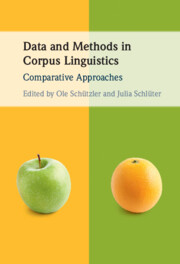Book contents
- Data and Methods in Corpus Linguistics
- Data and Methods in Corpus Linguistics
- Copyright page
- Contents
- Figures
- Tables
- Contributors
- Acknowledgements
- Introduction: Comparative Approaches to Data and Methods in Corpus Linguistics
- Part I Corpus Dimensions and the Viability of Methodological Approaches
- 1 Comparing Standard Reference Corpora and Google Books Ngrams
- 2 Comparing Approaches to Phonological and Orthographic Corpus Formats
- Part II Selection, Calibration and Preparation of Corpus Data
- Part III Perspectives on Multifactorial Methods
- Part IV Applications of Classification-Based Approaches
- Index
- References
2 - Comparing Approaches to Phonological and Orthographic Corpus Formats
Revisiting the Principle of Rhythmic Alternation
from Part I - Corpus Dimensions and the Viability of Methodological Approaches
Published online by Cambridge University Press: 06 May 2022
- Data and Methods in Corpus Linguistics
- Data and Methods in Corpus Linguistics
- Copyright page
- Contents
- Figures
- Tables
- Contributors
- Acknowledgements
- Introduction: Comparative Approaches to Data and Methods in Corpus Linguistics
- Part I Corpus Dimensions and the Viability of Methodological Approaches
- 1 Comparing Standard Reference Corpora and Google Books Ngrams
- 2 Comparing Approaches to Phonological and Orthographic Corpus Formats
- Part II Selection, Calibration and Preparation of Corpus Data
- Part III Perspectives on Multifactorial Methods
- Part IV Applications of Classification-Based Approaches
- Index
- References
Summary
The authors compare approaches to studying the effects of the prosodic Principle of Rhythmic Alternation on the basis of two fundamentally different corpus formats. The first consists of orthographic transcriptions of speech, or of originally written data, while the other one provides access to the sound files of the spoken data, too. The authors’ main argument is that the nature and size of the corpus determines, or at least constrains, the range of methods that can be applied – and as a corollary of this, the findings that can be gained. Due to the greater availability and accessibility of written and transcribed spoken corpus data, much of the evidence in prior research is rather abstract and comes from large corpora accessed via the orthographic route only. Exploiting the recently available sound files of parts of the spoken section of the original British National Corpus, the authors analyse the data from an auditory perspective. This direct and highly controlled approach partially converges with and adds to the findings of previous studies. Thus, both approaches can be shown to complement each other, resulting in a better overall understanding of the phenomenon at hand.
Keywords
- Type
- Chapter
- Information
- Data and Methods in Corpus LinguisticsComparative Approaches, pp. 46 - 72Publisher: Cambridge University PressPrint publication year: 2022



